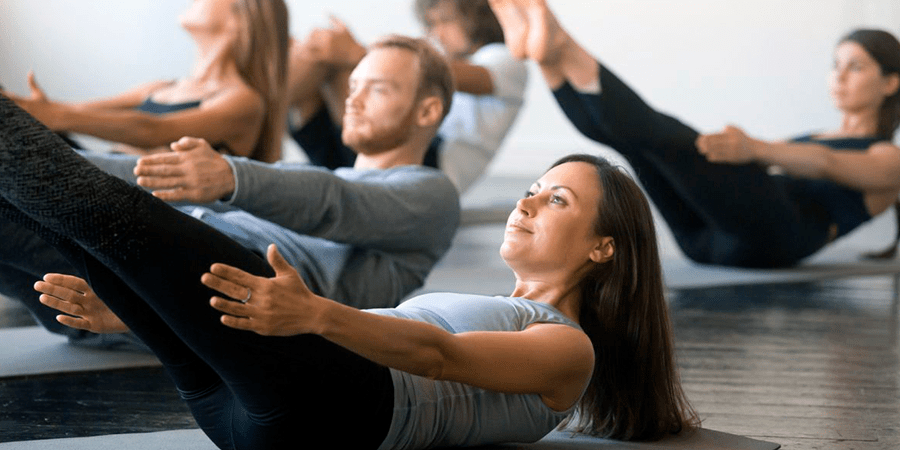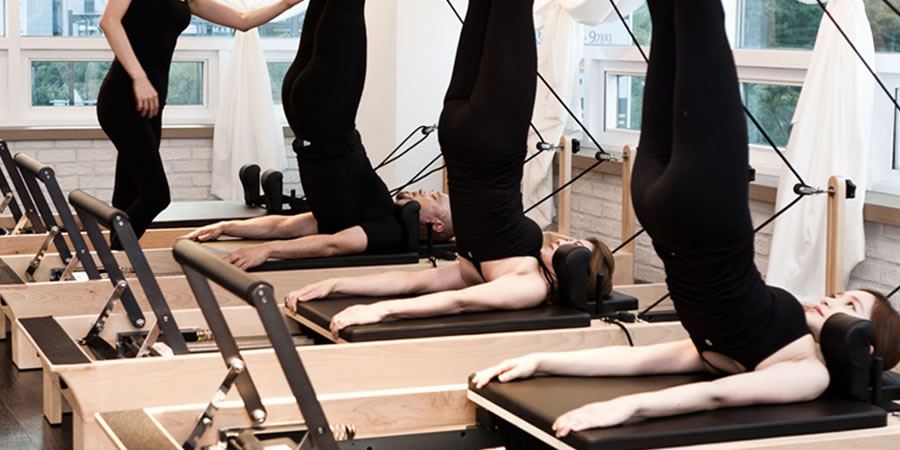The first time you take any new fitness class can be a little intimidating. But for some reason, Pilates classes have an extra air of “avoid this if you don’t know what you’re doing.” Maybe it’s the reformer, with its straps and springs. Maybe it’s the exercise names that you’ve never heard before. (What’s this “Pilates Hundred” thing?)
If you’ve wanted to try Pilates classes but something has been holding you back, now’s your time to sign up for your first one. Pilates offers plenty of benefits to your body, no matter your fitness background. You’ll improve your posture, focus on bodily alignment, and get one heck of a core workout.
Whether you’re on the mat or machine, you can snag the same benefits. A 2016 study found that eight weeks of Pilates classes improved abdominal endurance, flexibility, and balance. Plus, Pilates has seen a resurgence in popularity, with franchises such as Club Pilates popping up around the country.
Want to know what the hype is all about? Here’s everything a Pilates newbie needs to know to enjoy their first class.
What is Pilates, anyway?
Pilates is a form of low-impact exercise that aims to strengthen muscles while improving postural alignment and flexibility. Pilates moves tend to target the core, although the exercises work other areas of your body as well. You can do Pilates with or without equipment (more on that below), but no matter what, expect the moves to involve slow, precise movements and breath control. “Pilates is a full-body exercise method that will help you do everything better,” Sonja Herbert, a Pilates instructor and founder of Black Girl Pilates, tells SELF. “It strengthens and stabilizes your core body, which is your foundation, so that you can move efficiently while improving your posture, flexibility, and mobility.” A typical Pilates workout is 45 minutes to an hour long.
1. There are two different kinds of Pilates classes: mat classes and reformer classes.
You’ll be tackling a class that’s based on either a mat, which is a tad thicker than your standard yoga mat, to cushion pressure points, or a machine called a reformer, which is a sliding platform complete with stationary foot bar, springs, and pulleys that provide resistance. Know which one you’re getting into before you commit to your workout.
Both options focus on the concept of control rather than cranking out endless reps or muscle exhaustion. In Pilates, your muscles are working to lift against gravity and (in the case of the reformer) the resistance of the springs or bands, with the ultimate goal of strengthening and isolating the right muscles. Your goal should be to take your time with the exercises, focus on the task at hand, and connect to your breath.
“The reformer experience is maybe the most fun you’ll have in a Pilates class,” says Heather Andersen, founder of New York Pilates. “The machine gives you added resistance and a sliding surface that challenges your workout. It often feels like you’re flying or gliding.”
There are also many Pilates-inspired workouts, like SLT, Brooklyn Bodyburn, and Studio MDR, that aren’t considered “classic” Pilates but offer many of the same benefits. These studios use a next-level reformer called a Megaformer, which is larger than a traditional reformer.
Regardless of what class you choose, make sure to let your instructor know you’re a beginner. This way, they’ll be able to keep an eye on you throughout the class and offer modifications or form adjustments.
2. There are a few other pieces of equipment to know, but they probably won’t show up in most beginner Pilates mat classes.
Many Pilates mat classes don’t require any equipment other than, yes, a mat, which is usually provided. But other classes can use different equipment in addition to the reformer. The most common pieces of equipment are the Wunda, a low chair with padding and springs, the Cadillac (which looks a little like a bed with a canopy frame and is used in various ways for advanced students), the spine corrector, the high chair, and the Magic Circle, a ring you often use between your legs to create resistance. “In most class settings, you will typically use the reformer, the chair, Magic Circle, spine corrector, and a smaller version of the Cadillac called the tower unit,” says Herbert, who advises beginners to take a few private lessons, if possible, to safely learn how to use the equipment before signing up for a group class.

3. You’ll feel your muscles burn during class, and you’ll probably be sore the next day.
While you may not be crushing high-intensity exercises like squat jumps or lifting heavy dumbbells, the mostly bodyweight routines that Pilates classes offer can be pretty intense. Take the signature Pilates Hundred, for example. A core-focused move that involves less than two inches of constant movement will make your abs burn. A good instructor should give you modifications so that you can perform each movement with good form (another reason to introduce yourself as a beginner before class starts).
Dedicating your entire focus to even the smallest movements means that you’ll work the muscles that each exercise intends. And that means you can be dealing with muscle soreness after your workout. Don’t fret: While next-day soreness may be at a whole new level after your first week, your body will get more used to the movements with time. Being sore the next day just means you’re challenging your muscles in new ways or working muscle groups that don’t usually get much attention.
4. Pilates works several muscle groups.
“Pilates is not restricted to specific body parts,” Herbert says. Yes, Pilates moves focus on your core and trunk, but that doesn’t just mean your abs. “Although Pilates is specifically defined as exercise for the core or abdominal muscles, it is important that clients know that the core includes the entire trunk, which is the abdominals, the hips, the inner and outer thighs, and the back,” Herbert explains. So expect a workout that works your entire body.
5. Many beginner classes will feature the same group of exercises in each class.
There are an established set of Pilates moves that are common in beginner classes, Herbert says. They include:
- The Hundred (a breathing exercise that also targets core strength and stability)
- The roll up (a slow, precise move that stretches the spine and the back of the body and strengthens the abdominals)
- Leg circles (which strengthen the hips and core stabilizers)
- Rolling like a ball (which massages the spine and opens up the back)
- Series of 5 (a group of moves that strengthen the abdominals and back muscles)

6. Wear formfitting clothes—and don’t forget your socks!
Even if you typically prefer loose-fitting workout wear, you’re going to want to wear body-hugging options for Pilates classes. “This way, the instructor can see your movements better and your clothes don’t get caught in springs or other equipment,” says Carrie Samper, national Pilates training manager at Equinox.
“And leave the shorts at home too,” Samper adds. “There are many exercises in Pilates where you are lying down and your legs are moving above you…so you don’t want the shorts to ride up.” Instead, wear capris or leggings with a tank top or fitted long-sleeved shirt.
As for footwear, you can either be barefoot or wear socks for your session. Most studios have their own suggested protocol. Find it on the studio’s website, or ask the front desk when you check in for your class.
If you’re going to go for socks, find yourself a pair with rubber detailing on the soles so you don’t slip on the mat or machine. A barefoot or socks-only approach will also help you navigate in and out of the straps on a standard reformer with ease.
7. Every studio has different lingo they use in class. Look to regulars for form help when you’re not up with the terms.
Every workout from barre to CrossFit has its own set of terminology, Pilates included. For Pilates, know that your “powerhouse” refers to the the center of your body, where all of your power comes from to execute movement. “Peel through your spine” means slow movement from vertebra to vertebra. Don’t fret: You’ll get used to it with time.
In the meantime, look to regulars who catch on to the instructions quickly. The best way to do this? Put yourself in the middle of the room. Whether it’s on a reformer or a mat, planting yourself in the center allows you an optimal view of all of the action. “In the middle, the instructor is easily visible,” says Samper. “The other participants can help visually guide you through transitions while the instructor migrates to offer adjustments.”
8. Pilates should be a part of a well-rounded fitness plan.
Even if a studio offers unlimited classes for the first week, don’t plan on hopping into a class every day. Your body needs a day or two to recover from fatiguing resistance exercise such as Pilates.
“Pilates stretches, strengthens, and aligns your body all at the same time,” says Samper. “With that said, it also complements every other fitness endeavor because it prepares your body to move better in every way. Adding it into your routine will help you lift heavier weights, run faster, swim with better form, or even achieve that elusive arm balance in yoga.”
Source: https://www.self.com/story/5-things-to-know-before-you-take-pilates-classes








